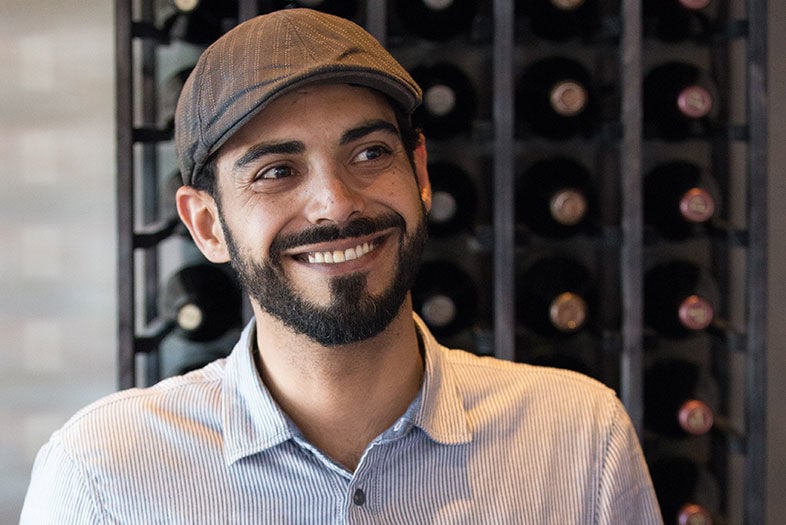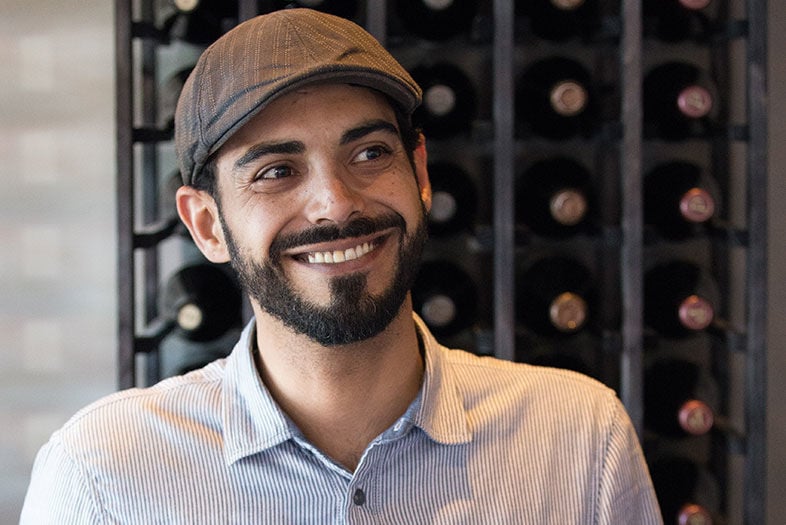After working as a bartender for more than a decade, Sami Saltagi has been asked “Where are you from?” enough to have perfected a five-second autobiography: Born in Italy to an Italian mother and Syrian father, he was raised in Damascus. He moved to Florence to serve in the Army for 10 months (military service is mandatory in both Italy and Syria) and then started bartending in Florence while working on a graphic design degree.
Saltagi, who runs the bar program at French bistro Et Voila in North Park, moved to San Diego two years ago after nearly a decide in San Francisco, where he worked at a cocktail bar in the Tenderloin called Lush Lounge, a hole-in-the-wall that prided itself on well-made drinks. He left San Francisco, he says, for the same reason many folks are leaving the city: “Leases were really expensive, life was expensive, and I just kind of felt like people were doing a little too much too quick. I came down here to kind of follow my way.” It’s a path he started down thanks to his parents, whom he describes as “foodies,” who were very involved in Syria’s international community. His father was an architect and his mom volunteered with NGOs and would often host dinner parties.
When Saltagi isn’t behind the bar at Et Voila, he volunteers with the International Rescue Committee, a San Diego nonprofit that provides assistance to refugees. Saltagi helps Syrian refugees learn how to navigate life in the U.S.—how to use Google translator and Google maps, how to search for a job, how to use the bus system. “When you teach them something new and they’re, like, OK, this is going to make my life easier, I’m glad someone told us, it’s rewarding,” he says.
Talking to Saltagi about life in Damascus, what it’s like to have been a solider in one of the world’s most beautiful cities, and his work with the IRC are all topics worthy of their own Q&As, but since this blog is about cocktails, we shifted our conversation to Saltagi’s vision for the bistro’s cocktail program.
Et Voila is a French restaurant, but you’ve got all these influences from all over the world. Do you have a philosophy for cocktail menus?
Yes and no. I do have a philosophy, but most of it has been kind of figuring out what the crowd wants here, because we’re a new place, we’re in a new neighborhood. I was trying to get a feel for what people would and would not like. There are a lot of things I thought they would like and a lot of things I didn’t think they’d like that have been amazing. What I’m trying to do now with the new menu is, I want to incorporate a lot of the French flavors—pastis, Chartreuse, Suze. They’re all very bitter and strange. The way they would drink them [in France] might not be completely acceptable to someone here. I want to incorporate those flavors in certain cocktails so people can recognize something, but still have a sense of mystery for the new flavor.
We try to use a lot of fresh produce. We have a cucumber gimlet where we use a slow juicer to make fresh juice. We’re trying to so some summery cocktails. We added a spritzer. The idea is to have cocktails with things that people know and things that they can discover in the same drink. I want to use the French flavors as much as we can.
Speaking of the spritzer (the Rose Spritz made with rosé wine, rosé vermouth, Seville orange bitters, and seltzer), who makes the rosé vermouth?
That’s one’s new. It’s really tasty. What I’m working on as well is a rosé negroni. It’s subtle. It’s made by Brovo Spirits. The other thing I just tried is [Brovo’s] orange curaçao. This we’re using as a substitute for Triple Sec. I’m playing around with it and trying to do a more herbaceous cocktail.
Note: If you find either of these Brovo products, grab ‘em. The rosé vermouth would be fun to swap into a cocktail calling for sweet vermouth. The orange curaçao was one of the best I’ve tried.

Meet the Bartender: Et Voila’s Sami Saltagi
Huckleberry Bourbon
What are the most popular cocktails on the current menu?
We sell these three like no other (he points to the first three cocktails on Et Voila’s menu: the Blooming Manhattan [Old Forester bourbon, Pavan orange blossom liqueur, Gran Classico, Carpano Antica sweet vermouth, and orange bitters], Black Rye Manhattan [Old Overholt rye whiskey, Carpano Antica sweet vermouth, Amaro Averna, orange and Angostura bitters], and the Huckleberry Bourbon [Old Forester bourbon, maple-agave infused huckleberries, and lemon]).
What’s your favorite spirit to work with?
At the moment, whiskey… I had a phase with tequila and mezcal, but now it’s mostly whiskey.
And now the question I always ask: I wish people would stop ordering _______________ and instead try _______________.
I don’t have that at all—maybe it’s because of my background. I know people just want what they want in that moment. Yeah, I used to cringe because people would order a cosmo, but then it’s because I just heard people say that they cringe when they order a cosmo. I used to have a thing if people would order a Bloody Mary at night, but who am I to judge who wants a Bloody Mary at night? I might feel that if someone tried something different, they’d be a little happier because it’s a new experience—they tried a new flavor, they had a new moment—but some people become miserable if you change their habits. I’m going to make whatever you want, make it as good as you can, and hope you’re happy about it.
Would you ever go back to visit Syria?
At one point, I definitely wanted to go back and open something there because there was such huge potential. What Beirut was in the ’80s and ’90s, before the war, that’s the way Damascus became. When I left in 2000 and then the president died and the son took over… it had bars, cafes, clubs, nightclubs, patio seating. They had a restaurant that had, I think, 1,500 patio seats, people would go night and day…. I have a very good friend who used to own a bar [in Damascus] and he moved to San Francisco. He moved as a refugee and got asylum here. He had opened the bar with a $1,000 investment, but then the war broke out and he was a Muslim in a Christian neighborhood.
When I left, the three years I was not there, everybody told me that Syria moved forward in three years more than it had in 20. And that’s why everything started stumbling and falling—Damascus became like a renaissance area and the rest of the country starved, and so they revolted and six years later, this is what we have.
Got an idea for a future post? Email me.

Meet the Bartender: Et Voila’s Sami Saltagi
PARTNER CONTENT
Et Voila’s Sami Saltagi















